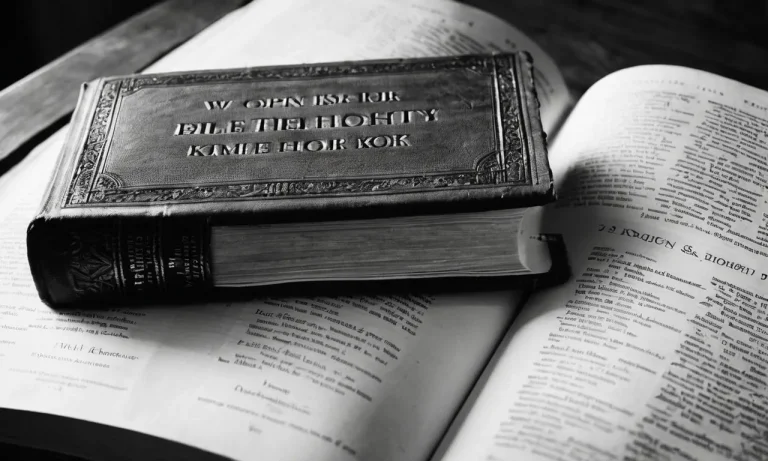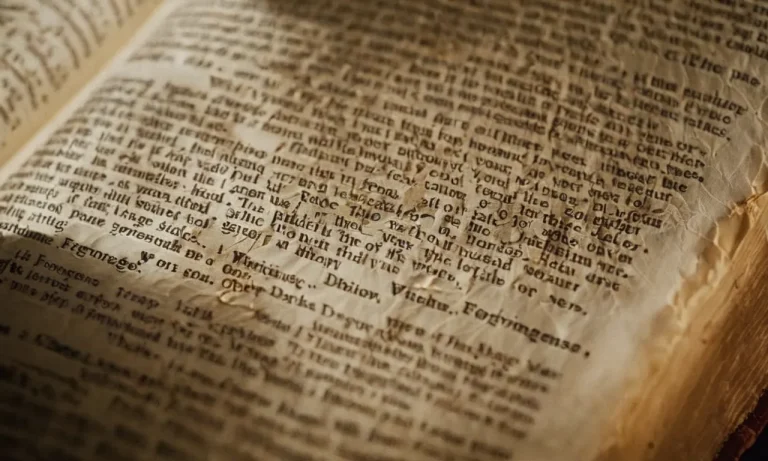What Is The Veil In The Bible? A Comprehensive Guide
The veil is referenced numerous times throughout the Bible, but what exactly does it represent? If you’re short on time, here’s a quick answer: The veil in the Bible symbolizes the separation between God and humanity due to sin.
In this comprehensive guide, we will explore the meaning behind the biblical veil, looking at key verses and examples of how the veil is used as a metaphor in both the Old and New Testaments. We’ll examine the veil in the tabernacle, the tearing of the temple veil after Jesus’ crucifixion, and the veil metaphor used by Paul.
By the end, you’ll have a thorough understanding of the deep spiritual significance behind this important biblical symbol.
The Veil in the Tabernacle
The tabernacle was the portable sanctuary that the Israelites used for worship during their time in the wilderness after the Exodus from Egypt. Within the tabernacle complex was a special inner room called the Holy of Holies, which contained the Ark of the Covenant and where God’s presence dwelled.
A thick curtain or veil separated the Holy of Holies from the outer room called the Holy Place.
The Layout and Contents of the Tabernacle
The tabernacle was laid out in a rectangular shape and was surrounded by an outer courtyard. Upon entering the courtyard, the first structure one would encounter was the altar of burnt offering, where animal sacrifices were made.
Beyond the altar stood the bronzewash basin, used by priests to wash before entering the tabernacle proper. The tabernacle structure itself had an outer chamber called the Holy Place, which contained the lampstand, the table of showbread, and the altar of incense.
The inner chamber was the Holy of Holies, which contained the Ark of the Covenant and was separated from the Holy Place by a thick curtain or veil.
Only Priests Could Enter the Holy of Holies
Access to the tabernacle’s two inner rooms was highly restricted. Only priests could enter the Holy Place to tend to the lamps, bread, and incense altar. And only the High Priest could enter the Holy of Holies, and then only once a year on the Day of Atonement to sprinkle blood on the Ark’s mercy seat as an atonement sacrifice for the people’s sins.
Any other person who entered the Holy of Holies would die (Leviticus 16:2). This severe restriction highlighted the sacredness of God’s presence in the inner room.
The Veil as a Barrier Between God and Man
The veil that separated the Holy Place from the Holy of Holies powerfully symbolized the separation between God and humanity. While the High Priest could pass through the veil once annually, access to God’s presence was severely limited.
The author of Hebrews states that the veil represented how the people were barred from God’s presence while the first covenant was still in effect (Hebrews 9:8). Only with Christ’s later sacrifice on the cross could humanity boldly approach God’s throne of grace (Hebrews 4:16).
When Christ died, Scripture records that the veil was torn in two from top to bottom, graphically symbolizing the free access believers now have to God through Christ (Matthew 27:51).
The Torn Veil After Jesus’ Death
Jesus’ Sacrifice Enabled Direct Access to God
When Jesus died on the cross, the veil that separated the Holy of Holies from the rest of the temple was torn in two from top to bottom (Matthew 27:51). This signified that through his sacrifice, Jesus opened the way for all people to approach God directly.
No longer did a high priest need to enter the Holy of Holies once a year to make atonement for the people’s sins. Jesus became the great high priest who made the perfect and final atonement for sins (Hebrews 4:14-16).
The torn veil illustrated that Jesus’ death provides direct access to God for all who believe in him. The writer of Hebrews says “we have confidence to enter the Most Holy Place by the blood of Jesus” (Hebrews 10:19).
The torn veil also symbolized the tearing or breaking down of the barrier between Jews and Gentiles. Through faith in Christ, both groups are reconciled to God and united in the church as one body (Ephesians 2:14-18).
Old Testament Imagery and Parallels with the Torn Veil
The veil being torn at the moment of Jesus’ death reflected Old Testament imagery about access to God. When the temple was dedicated, God’s glory filled it, indicating His presence dwelled there (1 Kings 8:10-11). The Holy of Holies was where God manifested His presence on the Ark of the Covenant.
Only the high priest could enter it once a year on the Day of Atonement after elaborate cleansing rituals and blood sacrifices (Leviticus 16:1-34).
The torn veil paralleled this limited access to God’s presence. It demonstrated Jesus’ sacrifice ended the old covenant rituals and made God accessible to all. Another parallel was with the temple veil tearing when the Babylonians destroyed the first temple (2 Kings 25:9).
This signified God’s judgment and the loss of His presence. However, Christ’s torn veil showed God’s presence returning through a new and better covenant in Jesus’ blood (Luke 23:45, Hebrews 8:6, 13).
Paul’s Use of the Veil as a Metaphor
The Veil Covering Moses’ Face
When Moses spoke with God on Mount Sinai, his face shone brightly from being in God’s presence. This made the Israelites afraid, so Moses put on a veil to cover his radiant face when addressing them (Exodus 34:29-35).
Paul used this story as a metaphor in his letter to the Corinthians, contrasting the glory of the old and new covenants.
The Hardened Minds of the Israelites
Paul explained that the minds of the Israelites were hardened, preventing them from fully understanding the glory of God in the old covenant. Just as Moses’ veil kept them from seeing the fading glory on his face, their spiritual blindness veiled them from fully grasping the purpose and temporary nature of the law and old covenant (2 Corinthians 3:7-15).
Removing the Veil Through Faith in Christ
However, when anyone turns to Christ, this veil is removed. As 2 Corinthians 3:16 states, “whenever anyone turns to the Lord, the veil is taken away.” With open spiritual eyes enlightened by the Holy Spirit, believers in Jesus can comprehend the surpassing glory of the new covenant.
Just as Moses unveiled his face when addressing God’s glory on Mount Sinai, through faith in Christ all barriers from seeing and understanding God are removed. As Paul wrote, all believers can come before God with unveiled faces, beholding His glory and being transformed into His image (2 Corinthians 3:17-18). The glory of the old covenant fades in comparison to the eternal glory brought through the new covenant established in Christ.
Conclusion
In summary, the veil was a key symbol in both Old and New Testament times representing the separation between God and humanity. While the elaborate temple veil kept the Holy of Holies shielded, Christ’s sacrifice provided believers direct access into God’s presence.
As Paul explained through his veil metaphor, only through Christ can the veil over our hearts and minds be removed. When studied closely, the biblical veil contains a deep spiritual truth about the dividing barriers of sin and the redemptive power of the cross.








